| Rusty pittosporum | |
|---|---|
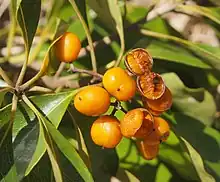 | |
| Fruit | |
| Scientific classification | |
| Kingdom: | Plantae |
| Clade: | Tracheophytes |
| Clade: | Angiosperms |
| Clade: | Eudicots |
| Clade: | Asterids |
| Order: | Apiales |
| Family: | Pittosporaceae |
| Genus: | Pittosporum |
| Species: | P. ferrugineum |
| Binomial name | |
| Pittosporum ferrugineum | |
| Synonyms[3] | |
| |
Pittosporum ferrugineum, commonly known as the rusty pittosporum or rusty-leaved pittosporum, is an evergreen plant in the family Pittosporaceae native to Malesia, Papuasia, the Northern Territory and Queensland.
Description
Pittosporum ferrugineum is a shrub or small tree growing to around 10 m (33 ft) high. The new growth (twigs, leaves and flowers) is densely covered in fine rusty-brown hairs − giving rise to the common name − but becoming less hairy as it matures. Leaves are dull green, elliptic to narrow-elliptic, 6–13 cm (2.4–5.1 in) long by 2–5 cm (0.79–1.97 in) wide, on a petiole 1.5–2.5 cm (0.59–0.98 in) long.[4][5]
The inflorescences are clusters of flowers about 4 cm (1.6 in) wide,[6] produced in the leaf axils at any time of the year. The fragrant flowers have five petals, measure about 10 mm (0.39 in) long and wide, and are white, cream or yellow in colour.[7]
The dull yellow or orange fruit is a dehiscent 2-valved capsule containing up to 16 small red seeds aggregated into a sticky ball.[4][5][7]
Taxonomy
This species was first described − albeit very briefly − and named in 1811 by the English botanist William Townsend Aiton in the book Hortus Kewensis.[8]
Subspecies
There are two subspecies of this taxon recognised by Plants of the World Online (POWO) − P.f. laxiflorum Schodde, and the autonym P.f. ferrugineum.[3] A former subspecies − P.f. linifolium was elevated to species status in 2017 under the combination Pittosporum tinifolium.[9]
Etymology
The species epithet ferrugineum is from the Latin ferrugineus, meaning "of the colour of rust", and was given to this species by Aiton in reference to the dense red-brown hairs on the plant.[7]
Distribution and habitat
The rusty-leaved pittosporum is found in Malesia, Papuasia and northern Australia, with records from Malaysia, Borneo, Sulawesi, the Philippines, the Caroline Islands, Java, Sumatra, Lesser Sunda Islands, the Maluku Islands, New Guinea, the Bismark Archipelago, the Solomon Islands, Christmas Island, the Northern Territory and Queensland (north of Cooktown). It has been introduced to Mauritius, Sri Lanka, Cambodia and Vietnam.[3][10]
This species is known to inhabit drier rainforest types such as monsoon forest, beach forest and the margins of mangrove forest.[4][6]
Ecology
The fruit of this species is eaten by metallic starlings (Aplonis metallica).[7] Flowers attract a variety of birds and butterflies.[6]
Conservation
This species is listed by the Queensland Department of Environment and Science as least concern.[1] As of 21 February 2023, it has not been assessed by the IUCN.
Gallery
 An opened fruit showing seeds
An opened fruit showing seeds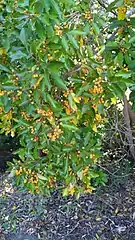 Shrub laden with fruit
Shrub laden with fruit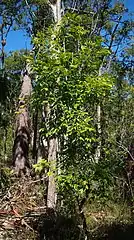 Near Yeppoon, central Queensland
Near Yeppoon, central Queensland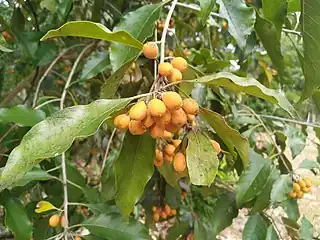 Close up of fruit
Close up of fruit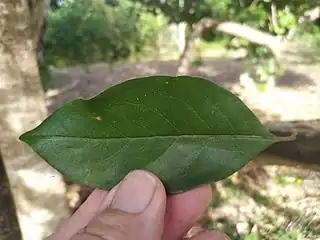 Leaf, top side
Leaf, top side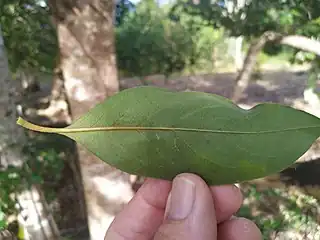 Leaf, underside
Leaf, underside
References
- 1 2 "Species profile—Pittosporum ferrugineum". Queensland Department of Environment and Science. Queensland Government. 2022. Retrieved 21 February 2023.
- ↑ "Pittosporum ferrugineum". Australian Plant Name Index (APNI). Centre for Plant Biodiversity Research, Australian Government. Retrieved 21 February 2023.
- 1 2 3 4 "Pittosporum ferrugineum W.T.Aiton". Plants of the World Online. Royal Botanic Gardens, Kew. Retrieved 21 February 2023.
- 1 2 3 F.A.Zich; B.P.M.Hyland; T.Whiffen; R.A.Kerrigan (2020). "Pittosporum ferrugineum". Australian Tropical Rainforest Plants Edition 8 (RFK8). Centre for Australian National Biodiversity Research (CANBR), Australian Government. Retrieved 21 February 2023.
- 1 2 Cayzer, Lindy W. (2022). Makinson, R.O. (ed.). "Pittosporum ferrugineum". Flora of Australia. Australian Biological Resources Study, Department of Climate Change, the Environment and Water: Canberra. Retrieved 21 February 2023.
- 1 2 3 "Pittosporum ferrugineum W.T.Aiton". NParks Flora & Fauna Web. Singapore Government. Retrieved 22 February 2023.
- 1 2 3 4 Cooper, Wendy; Cooper, William T. (June 2004). Fruits of the Australian Tropical Rainforest. Clifton Hill, Victoria, Australia: Nokomis Editions. p. 402. ISBN 9780958174213.
- ↑ Aiton, William Townsend (1811). Hortus kewensis, or, A catalogue of the plants cultivated in the Royal Botanic Garden at Kew (2 ed.). London: Longman, Hurst, Rees, Orme, and Brown. pp. 27–28. Retrieved 21 February 2023.
- ↑ Cayzer, L.W.; Chandler, G.T. (2017). "Pittosporum tinifolium A.Cunn.: a corrected name and reinstatement at species level for the Queensland species currently known as the rusty-leaved pittosporum, Pittosporum ferrugineum subspecies linifolium (A.Cunn.) L.Cayzer et al. (Pittosporaceae)". Austrobaileya. 10 (1): 205–206. Retrieved 7 December 2023.
- ↑ "Pittosporum ferrugineum Dryand. ex Aiton". Global Biodiversity Information Facility. Retrieved 22 February 2023.
External links
 Data related to Pittosporum ferrugineum at Wikispecies
Data related to Pittosporum ferrugineum at Wikispecies Media related to Pittosporum ferrugineum at Wikimedia Commons
Media related to Pittosporum ferrugineum at Wikimedia Commons- View a map of historical sightings of this species at the Australasian Virtual Herbarium
- View observations of this species on iNaturalist
- View images of this species on Flickriver